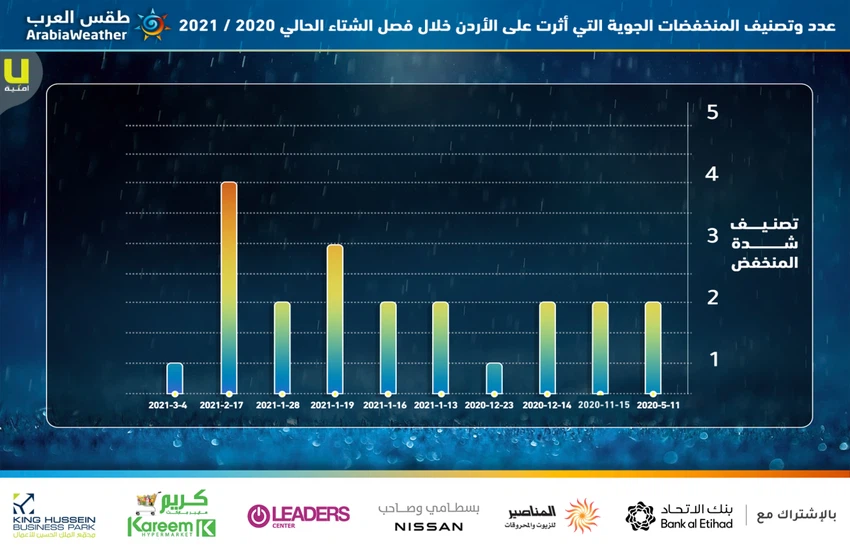Weather study: assessing the reality of the winter season and the rainy season 2021/2020 so far and forecasts for the coming weeks
Arab Weather - With our entry in March 2021, we may be starting something by starting something in the spring. In this study (prepared by colleagues Hisham Jamous, Muhammad Al-Shaker, and Muzaffar Rashid) we stand in a quick assessment of the reality of the rainy season in Jordan for the year 2021/2020 and its comparison with previous seasons.
First: assessing the reality and performance of the 2021/2021 rain season
To assess the reality and performance of the rainy season 2021/2020 (the climatic rain season begins in Jordan in the month of October and ends in May, of which three months of the winter season are 12, 1 and 2 months), we must look at several axes Which:
- The number of depressions that affected the Kingdom this winter.
- Comparing the number of depressions this winter with last winter and the previous one.
- The rain performance of the governorates in the governorates of the Kingdom.
- Performance up to date: (meaning how much the actual amount of rain that fell during this rainy season was verified in comparison to what was supposed to fall, which is calculated based on the rate of what fell during the past 30 years).
- What has been achieved in relation to the average annual rainy season as a whole (meaning how much the actual amount of rain has been achieved in comparison with what is supposed to fall during the whole season, which ends in the month of May, and the annual rate is calculated based on the thirty past years).
The number of depressions that affected the Kingdom this winter:
During the current winter season 2021/2020, the Kingdom was affected by ten (10) depressions, which were distributed as follows:
Comparing the number of depressions this winter with the previous winter and the previous one:
The number of depressions that affected Jordan in the current winter 2021/2020 decreased significantly and significantly compared to what was the case in the winter seasons 2019/2020 and 2018/2019, as shown below:
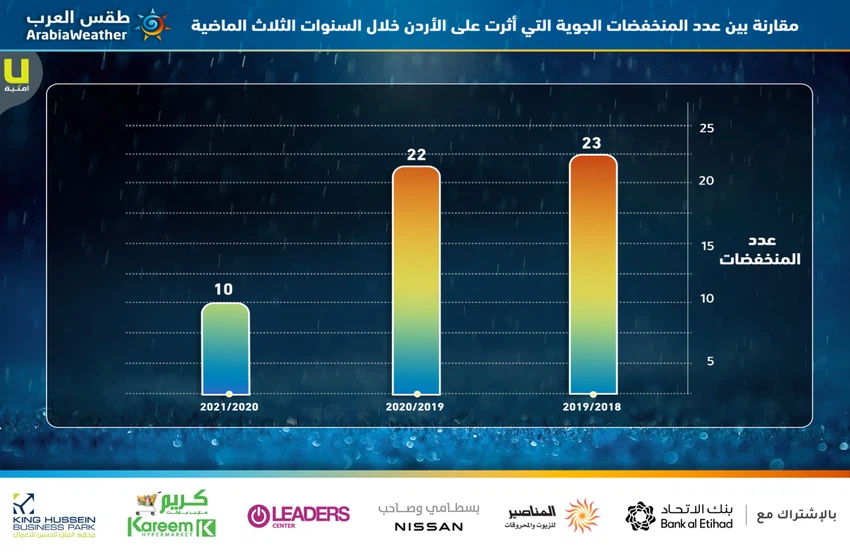
Also, if we take the number of depressions of third degree or higher (strong depressions that bring significant amounts of rain), we will find that the current winter season lacked strong depressions, as shown below:
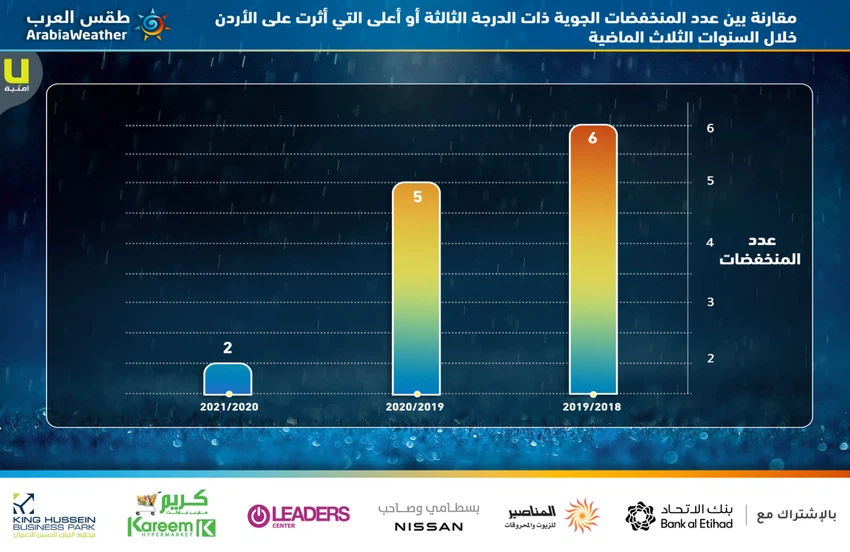
The rainy performance of the governorates relative to what is assumed until 4-3-2021:
When comparing the actual amount of rain falling in this rainy season with what is supposed to fall, which is calculated based on the rate of what fell during the past thirty years, we find that the performance of the rainy season until the moment is as follows:
- Override default sums : none.
- On the assumed totals : Zarqa city by 104%, Irbid city by 98%, then Aqaba by 97%, Ajloun 93%.
- Less than the assumed totals : Al-Mafraq 88%, Al-Asimah 85%, Al-Salt 87%, Madaba 83%, and the Southern and Eastern Badias 85%
- Much less than the assumed totals : Jerash 68%, Karak 62%, Tafila 50%, Shobak 44%, Maan 37%, and Wadi Musa, which has recorded a very bad season so far, at 13% of what is supposed to fall on it.
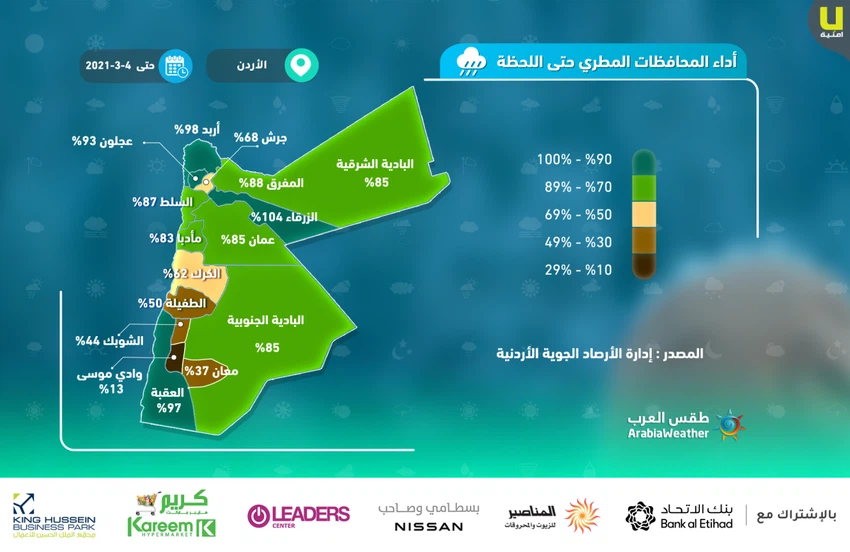
The amount of precipitation achieved in relation to the total annual rainfall:
When comparing the actual amount of rain falling during this rainy season with the full annual average (which ends in May), we find that until this date, no area has reached its annual rate, but the city of Zarqa has come close to that, for example. Whereas, the southern regions, with the exception of Aqaba, suffer from a great scarcity of rain this year, and Wadi Musa has not yet achieved 10% of the annual average rain, although only two months remain until the end of the rainy season. The drawing shows the arrangement of the regions in relation to what they achieved from the average annual rainfall.
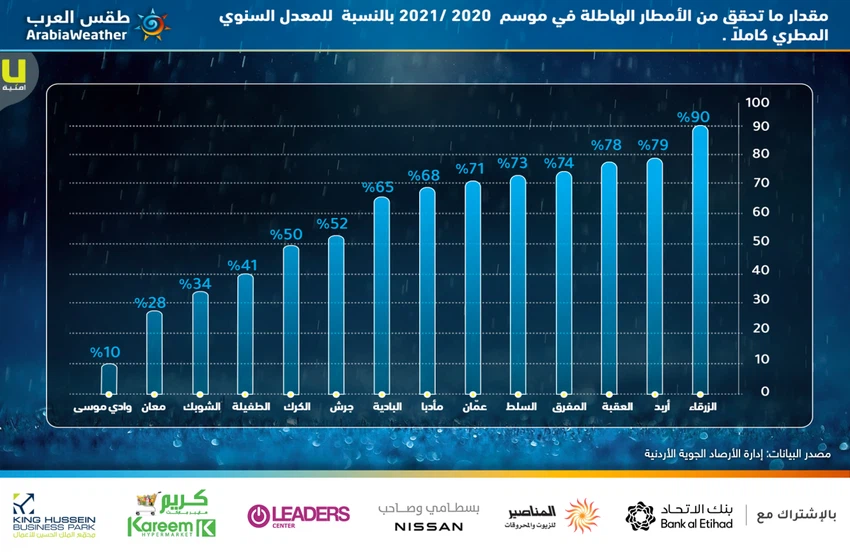
Second: Expectations for the rest of March and the coming weeks:
The monthly bulletin for March 2021 issued by the Arab Weather Center stated that the weather in the month of March will be characterized by the following:
- Early pentathlon depressions impose sharp fluctuations in the weather between significant temperature rises followed by cold air masses and rain.
- The third and fourth weeks may become overwhelming.
- The chances of torrential formation increased several times due to the nature of the conditions that are associated with the fluctuations of the weather systems, which in turn impose high atmospheric instability that leads to thunderstorms.
More details on the monthly newsletter from here.
Arabia Weather App
Download the app to receive weather notifications and more..
